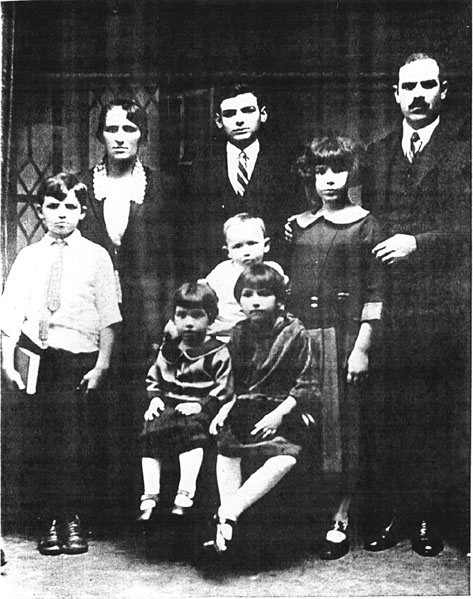This resource was developed as part of Linking Family History and World History by Linda Pomerantz.
Historians work with two types of sources, primary and secondary. Primary sources are those created at the time of the event, often by participants themselves. Secondary sources are those produced after the fact by historians, journalists and others, who construct a narrative or interpretation based on information received from primary sources.
Primary Sources
Oral recollections and family lore supply a great deal of information to help understand this photograph. At various times from 1970-1999, oral interviews were conducted with Sara Sarfaty, Jacob Sarfaty, Morris Sarfaty, Clara Pomerantz, Goldie Maletz, Celia Flax, Sam Sarfaty, Aaron Sarfaty, and Mollie Zucker. It is important to note that accounts often do not match.

Here are some basic facts about the photograph and the family:
- This is a photograph of the Sarfaty Family of New York City, probably taken in 1923.
- The family emigrated from Monastir, Macedonia, in 1913.
- They are Sephardic Jews.
- Ladino is their native language.
Those in the photograph are (left to right, top to bottom):
- Sara Elias Sarfaty (1889-1978)
- Morris (Moshe) Sarfaty (1906-1992)
- Jacob Sarfaty (1884-1957)
- Al (Abraham) Sarfaty (1915-1987)
- Clara (Miriam) Sarfaty Pomerantz (1911-1980)
- Goldie Sarfaty Maletz (b. 1920)
- Sam Sarfaty (b. 1922)
- Celia Sarfaty Flax (b. 1918)
Other family members are:
- Two sons, both named Eli, who died of diphtheria.
- Aaron Sarfaty (Harry) who was born in 1929 (after the photo was taken).
Secondary Sources
Students need to ask: What do I need to learn more about in order to understand this family’s history and its place in world history?
Students can brainstorm about ways to get more information. In addition to using the university library’s online catalog, encyclopedias, dictionaries, atlases and other reference works, students will begin to find other sources of information through (in this case): Sephardic temples, films, cookbooks, genealogical groups, etc. Once you start looking, you will find lots of material.
Obvious topics for this family’s history to start with might be: Sephardic Jews, Monastir, and Ladino language.
Reflective Questions
- In addition to photographs, what other primary sources would help me understand the history of the family I am studying?
- Where can I find other primary sources for the family’s history?
- What topics would help me understand the historical context for the family’s experience?
- Where can I find books, articles and on-line resources to learn about the historical context for the family’s experience?
- What resources does my University Library have that will help me in my quest?


